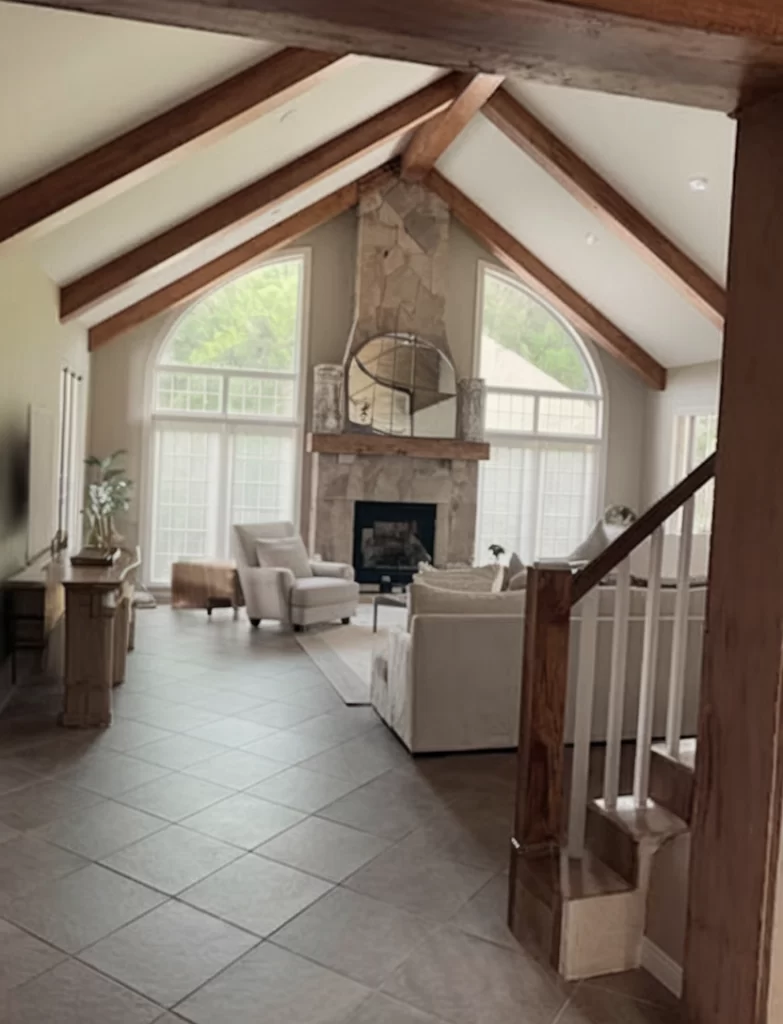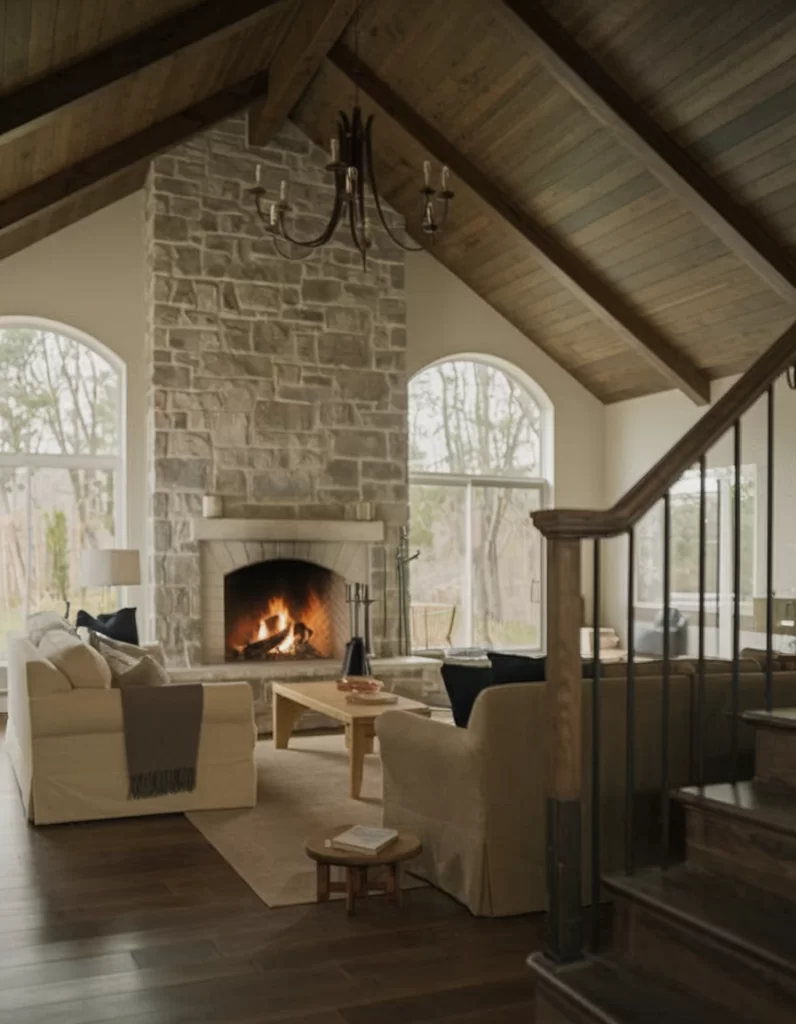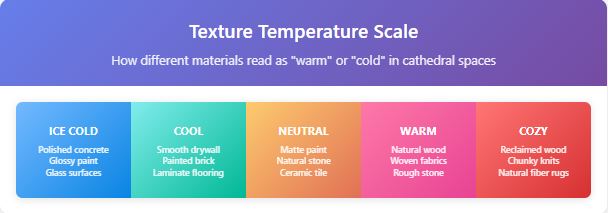Cathedral Ceilings in Living Rooms: The Power of Texture in High-Ceiling Spaces

The Power of Texture in High-Ceiling Spaces: Why Your Cathedral Ceiling Feels Cold (And How to Fix It)
Cathedral ceilings should feel grand and inspiring, but if yours feels more like a hotel lobby than a cozy home, you’re not alone. The secret to transforming these soaring spaces from cold and impersonal to warm and inviting isn’t about lowering the ceiling or adding more furniture—it’s about understanding the transformative power of texture.
Before

After

The Visual Temperature of Your Space
Before we dive into solutions, let’s talk about why cathedral ceilings often feel so unwelcoming. When we look at a room, our eyes don’t just see color and shape—they read texture as temperature. Smooth, reflective surfaces like painted drywall, polished stone, or glossy finishes send signals to our brain that register as “cold.” Meanwhile, rough, varied textures like natural wood, woven fabrics, or irregular stone create visual warmth that makes spaces feel more intimate and comfortable.
In cathedral ceiling spaces, this temperature reading becomes amplified. All that smooth drywall stretching up into the peaks creates a visual iceberg effect—impressive, but emotionally distant. The scale alone isn’t the problem; it’s the monotony of texture that makes these spaces feel sterile.

The Transformation Power of Layered Textures
The magic happens when you introduce multiple texture layers that work together to create visual interest and warmth. Think of texture as the difference between a plain white t-shirt and a chunky knit sweater—they might be the same color, but one feels approachable while the other feels distant.
In high-ceiling spaces, successful texture layering works on three levels: overhead, at eye level, and underfoot. Each layer serves a different purpose in making the space feel more human-scaled and inviting.

Overhead Texture: Softening the Sky
The ceiling in a cathedral space is like the sky in your room—it sets the entire mood. When that “sky” is flat white paint, it feels harsh and institutional. But introduce tongue-and-groove planking, exposed beams, or even a coffered treatment, and suddenly that vast expanse becomes interesting rather than overwhelming.
Wood planking is particularly effective because it creates natural shadow lines that break up the monotony while adding warmth through its organic texture. The linear pattern also helps the eye process the scale more comfortably, creating rhythm rather than emptiness.
Eye-Level Texture: Creating Connection
This is where most people focus their texture efforts, but in cathedral spaces, it’s crucial to think bigger and bolder. A single accent wall or small textured elements get lost in the vastness. Instead, consider substantial texture statements—like a floor-to-ceiling stone fireplace that anchors the room with its rough, natural surface.
The key is choosing textures that feel substantial enough to hold their own against the dramatic ceiling height. Delicate textures that work beautifully in standard-height rooms often disappear in cathedral spaces, leaving you back where you started.
Foundation Texture: Grounding the Space
The floor in a cathedral ceiling room works overtime to keep the space feeling grounded rather than floating. Hard, smooth surfaces like polished concrete or glossy tile can amplify the cold feeling, while textured options like natural stone, distressed wood, or even area rugs with substantial pile create a foundation that feels warm and stable.
The Psychology of Texture Contrast
Here’s where it gets really interesting: our brains are wired to find comfort in texture contrast. A room with all smooth surfaces feels sterile, while a room with all rough textures feels chaotic. The sweet spot is in the interplay between different texture types.
In cathedral spaces, this contrast becomes even more important because you’re working with such dramatic scale. Pairing the smooth painted walls with rough stone, or sleek furniture with chunky woven throws, creates a visual conversation that keeps the eye engaged and the space feeling dynamic rather than static.

The Role of Light in Texture Perception
Texture isn’t just about the surface itself—it’s about how light interacts with that surface. Smooth surfaces reflect light evenly, creating glare and harshness. Textured surfaces catch and scatter light, creating gentle shadows and depth that feel more natural and comfortable.
In cathedral spaces, this light interaction becomes crucial. Those soaring ceilings often mean lots of windows and dramatic light changes throughout the day. Textured surfaces help modulate that light, preventing the harsh glare that can make cathedral ceilings feel stark and uninviting.
Consider how different textures catch light differently: wood planking creates linear shadows, stone creates irregular patterns, and fabric absorbs light for softness. Layering these different light interactions helps create depth and interest in your vast space.
Common Texture Mistakes in Cathedral Spaces
The biggest mistake people make is thinking small. Texture elements that work beautifully in standard rooms often get lost in cathedral spaces. That gorgeous grasscloth wallpaper might be stunning in a dining room, but it could disappear entirely on one wall of a cathedral ceiling great room.
Another common error is going too matchy-matchy with textures. Using all wood textures or all stone textures creates monotony rather than the dynamic contrast that makes spaces feel alive. The goal is harmony, not uniformity.
Practical Texture Applications
Start with one major texture statement—perhaps a tongue-and-groove ceiling treatment or a substantial stone fireplace wall. This becomes your anchor point, giving the room a focal point that feels proportional to the space.
Then layer in supporting textures at a smaller scale: woven furniture, textured throws, natural fiber rugs, or even textured lampshades. These smaller elements shouldn’t compete with your major texture statement but should complement it, creating a rich tapestry of visual interest.
Don’t forget about functional textures—window treatments in cathedral spaces can be substantial enough to add significant texture while also helping control light and acoustics.
The Warmth Factor
Ultimately, the power of texture in cathedral ceiling spaces comes down to creating emotional warmth in a physically large space. When we walk into a room and immediately feel welcome and comfortable, it’s often because the textures are sending the right signals to our brain.
Cold, smooth surfaces make us feel like visitors in a space. Warm, varied textures make us feel like we belong. In cathedral ceiling rooms, this psychological impact is amplified because the scale already makes us feel small—texture helps us feel embraced rather than intimidated.
The transformation from cold and cavernous to warm and inviting isn’t about fighting your cathedral ceiling—it’s about understanding how texture can work with that dramatic scale to create something truly special. When done right, these spaces become the heart of the home, impressive yet intimate, grand yet genuinely comfortable.
